Garlic is an everyday staple in most households, used in cuisines worldwide. The bad news is, as much as humans prefer it in their food, so do many unwanted insects.
Garlic is a common ingredient in many pest deterrents yet is often the one under attack. Common pests include thrips, maggots, mites, and nematodes. Damage to your garlic can range from bruised and discolored plant tissue to rotten bulbs and hindered growth.
A relaxing day in the garden can quickly turn stressful if you see that your garlic crops are the victims of a bug infestation. Luckily there are various steps you can take to reduce the impact of the invasion and eliminate the critters.
How Can I Get Rid Of Bugs In My Garlic?
The first step is to recognize the type of insect in your garlic. Without knowing the species, your efforts to control any infestation might be in vain. Once you have identified the unwanted bugs, you should take action to destroy them and continue to monitor the planting area. Finally, consider implementing measures to avoid pests altogether in the future.
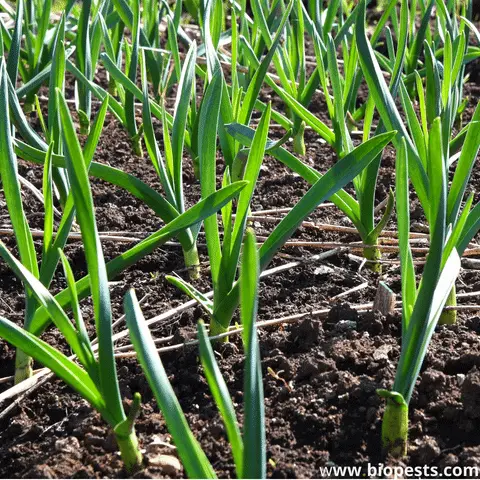
1. Identify The Bug
Scrutinize your garlic plant and see if you can identify the features of the bugs. If not, rely on other visual cues, such as damage to your garlic’s bulb, stem, or leaves, to pinpoint the culprits.
Characteristics of Thrips
Onion thrips (Thrips tabaci) and western flower thrips (Frankliniella occidentalis) are pests that attack onions, garlic, scallions, leeks, and chives. Both species are thin and tiny (1-1.5mm long) but visible to the naked eye. They are translucent brown or yellowish with two pairs of narrow hair-fringed wings.
Noticeable damage to your garlic can include:
- Silvery streaks on leaves
- Whitish spots on leaves
- Distorted or undersized bulbs
- Wilting and death of plants
- Tiny black “tar” spots of thrips excrement on leaves
Characteristics of Onion Maggots
Onion maggots (Delia antiqua) prefer garlic, onions, shallots, and leeks. Adult onion maggots are slender, with bodies covered in grey bristles. They are relatively large (1cm/0.39” long), yet smaller than a house fly, with wings that enable them to fly up to a mile to find host plants.
Noticeable damage to your garlic can include:
- Wilted, drooped, or stunted leaves
- Pale green or yellow leaves
- Rotting at the roots
- Misshapen bulbs
For more info about onion maggots, you can read here.
Characteristics of Red Spider Mites
Red spider mites (Tetranychus urticae) are part of the Acaridae family and attack various plants, including garlic. The male red spider mites are smaller than females and relatively colorless, with a black spot on either side of their wedge-shaped bodies. Adult females are red, have an elliptical shape, and grow to about 0.5cm/0.02” in length.
If red spider mites are present, you may notice silk webs on your garlic or “pockets” of feeding mites near the midrib and veins of the plants.
Other noticeable damage to your garlic can include:
- Small, stippled dots on the upper surface of the leaves
- Bleached, discolored leaves that may fall off
Characteristics of Bulb Mites
Bulb mites (Rhyzoglyphus spp., Tyrophagus spp.) feed off plants with bulbs, like garlic, onion, lilies, and tulips. Bulb mites feast in groups at the base of the plant’s roots. These mites have a 0.5-1mm long, oval-shaped body and look like damp pearls because of their shiny cream, white and brown color.
Noticeable damage to your garlic can include:
- Bruised or cut bulb tissue
- Small, raised brown blisters under the skin of garlic cloves
- Stunted plant growth
- Rotten bulbs
Characteristics of Eriophyid Mites
Dry bulb mites (Eriophyes tulipae) and wheat curl mites (Aceria tosichella) are part of the Eriophyidae family. They are tiny, microscopic, banana-shaped pests that tend to attack garlic, onions, leeks, and tulips. These eriophyid mites are usually 0.3mm long and look like tiny, curled worms.
Noticeable damage to your garlic can include:
- Galls (i.e., abnormal growths)
- Twisted, stunted leaves that fail to develop
- Curling and yellowing leaves
- Dry cloves with sunken, brown spots (only noticeable when in storage)
Characteristics of Nematodes
Garlic bloat nematodes (Ditylenchus dipsaci) are flat, microscopic roundworms that can make their way into the bulbs, stems, and leaves of your garlic. Some nematodes benefit plants, but the garlic bloat variety is a destructive parasite that destroys mostly garlic, onions, leeks, and chives.
Noticeable damage to your garlic can include:
- Yellow leaves
- Wilting leaves
- Swollen or “bloated” bulbs (hence the name of this pest)
- Soft, brown bulbs
2. Manage The Infestation
Depending on the type of bugs feasting on your garlic, take appropriate action to eliminate the infestation. Control can be exercised culturally, biologically, or through chemicals.
Controlling Thrips
If you have identified the pest in your garlic as thrips, you should consider the following control measures to address the infestation.
Cultural control:
- Remove cull piles, debris, and volunteer plants from the field.
- Install overhead irrigation, like a sprinkler system. Overhead watering can help keep plants thrip-free, as these bugs thrive in hot, dry conditions.
- Remove or destroy any sources of the thrip infestation. However, hold off on removing weeds until they begin to dry out. Controlling weedy areas before then may increase a thrips problem.
- Crop rotation is advisable.
- Adjust the transplanting dates.
- Use reflective, silver-painted, or aluminum-painted black mulches to repel thrips.
- Plant barrier crops that surround your garlic. Two rows of maize or an inner row of wheat and an outer row of maize surrounding the plot will suffice.
Biological control:
- Consider using natural predators like green lacewings, ladybugs, parasitic wasps, syrphid flies, minute pirate bugs, praying mantis, damsel bugs, coccinellids, beneficial nematodes, and spiders.
- Plant a mixed vegetable or flower garden to ensure a healthy predator population. For example, dandelions in your yard attract lacewings like dill, coriander, and fennel flowers.
Chemical control:
- The following products are registered to control thrips: Malathion, Matador, Silencer, Delegate, Success, Entrust, Movento, Exirel, Agri-Mek.
- You can also try using insecticidal soap for moderate infestations (the recipe here) and Spinosad or neem oil spray for heavier infestations.
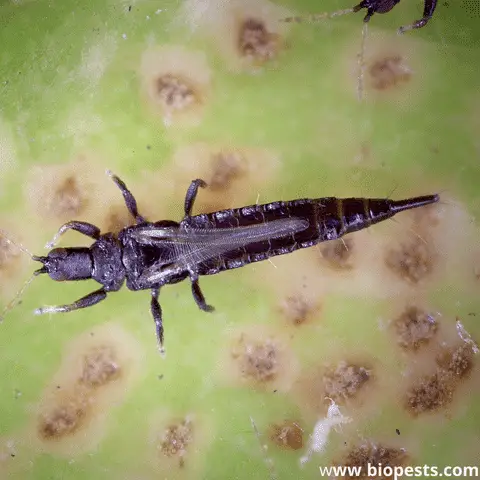
Controlling Onion Maggots
If you have identified the pest in your garlic as onion maggots, you should consider the following control measures to address the infestation.
Cultural control:
- Crop rotation is advisable.
- Harvest all bulbs, and remove culls, volunteer crops, and crop residues from the field to avoid overwintering populations.
- Add food-grade diatomaceous earth (also called DE) to the area around your garlic plants to kill the soft-bodied larvae once they hatch. Reapply after periods of rain.
Biological control:
- Add grassy refuge strips to the area to conserve predators that feast on onion larvae, such as parasitic wasps, predatory flies, ground beetles, rove beetles, beneficial nematodes, and spiders.
Chemical control:
- Clear out the affected soil and garlic plants and spray the area with a pest control product.
- For a natural insecticide, choose a Spinosad-based spray.
- For a registered chemical product that will kill onion maggots, choose Lorsban (chlorpyrifos).
- Use sprays, preferably in the morning or early evening.
- Spray the weeds surrounding the garlic, which will give additional protection.
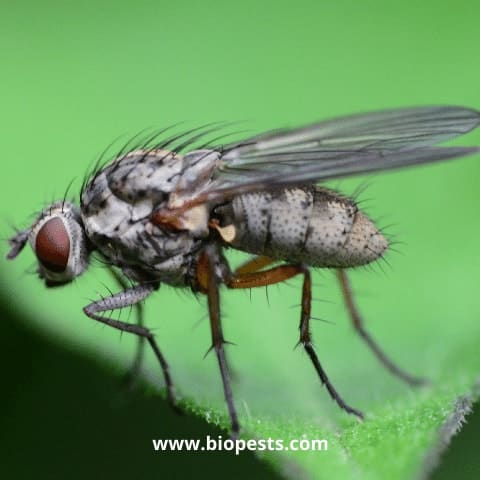
Controlling Red Spider-, Bulb-, and Eriophyid Mites
If you have identified the pest in your garlic as mites, you should consider the following control measures to address the infestation.
Cultural control:
- Spray your garlic plants thoroughly with water to wash off the mites or install an irrigation system.
- Sanitize the infested areas where you stored the bulbs.
- Apply crop rotation with crops less susceptible to bulb mite damage.
Biological control:
- Conserve predators such as lacewings, ladybugs, anthocorid bugs, mired bugs, hover flies, rove beetles, spiders, coccinellids, cecidomyiid flies, and gall midges.
- Pull and destroy the infected garlic plant or plants, and then let 1-2 live predators loose for every square foot of the affected area.
Chemical control:
- Apply a commercial or homemade insecticidal soap spray or an organic insecticide made from neem oil-based products to the infested area.
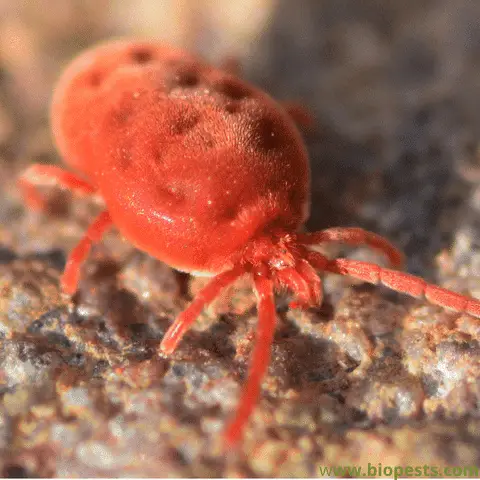
Controlling Nematodes
If you have identified the pest in your garlic as nematodes, you should consider the following control measures to address the infestation.
Cultural control:
- Remove any dead Allium material from your planting area.
- Remove all weeds surrounding the garlic, especially field thistle and hairy nightshade. These weeds can play host to a variety of pests, including nematodes.
- Clean and sanitize your garden tools and clothes before and between each planting session.
Biological control:
- Conserve predators such as beneficial nematodes.
Chemical control:
- If you want to use an insecticide, a high concentration of neem oil spray can kill parasitic nematodes while leaving beneficial ones unharmed.
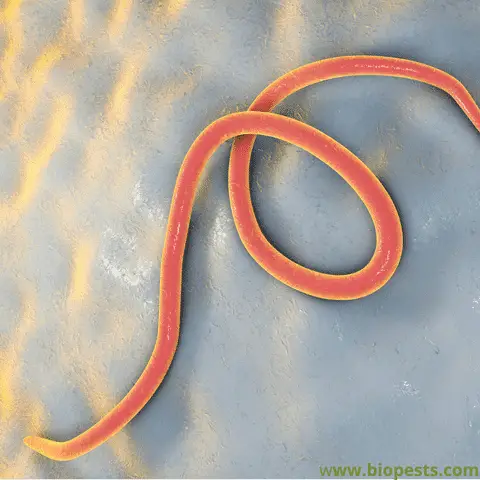
3. Continue To Monitor The Situation
Make sure to regularly inspect the leaves of your garlic plant with a hand lens to see if you can detect any critters that might be damaging your garlic. Continue with crop rotation, and make sure to practice thorough field sanitation.
You can also introduce measures that could alert you to pests before they reach your garlic plant. For example, you can set up white sticky traps around the edges of your planting area to capture first-generation thrips or onion maggots. Ensure to change these lures weekly.
4. Be Proactive
Prevention is always better than cure. Plan for your next sowing phase and implement measures that will help you avoid pests altogether. Some examples of good practices include:
- Avoid planting garlic near crops that are prone to pests.
- Use resistant/tolerant garlic varieties.
- Sow garlic in raised beds or containers, rotating it yearly with other crops such as carrots.
- Cover your garlic crops with a floating row cover immediately after planting.
- Avoid close spacing while planting.
- Use clean seed (cloves) when you plant your garlic. Additionally, you treat the cloves by soaking them in hot water (130°F for 10–20 minutes) before planting.
- Allow organic material to decompose by leaving fields unplanted between the harvests.
- Avoid planting any Alliums in the same area for four years.
Conclusion
Growing vegetables, like garlic, can be a very satisfying experience, but it can also be challenging if unwanted critters raid your crops.
Always ensure that you regularly rotate crops, cover newly planted seedlings immediately, and provide your garlic with enough water and proper soil drainage to avoid pest issues.
Some of the links above are affiliate links, meaning, at no additional cost to you, I will earn a commission if you click through and make a purchase.

